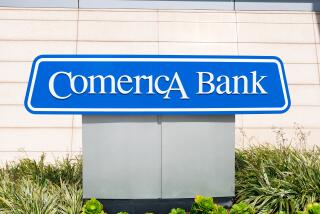S&L; Industry Losses Dip to $3.6 Billion in 2nd Quarter
- Share via
WASHINGTON — The financially beleaguered savings and loan industry got some unaccustomed good news Thursday as the Federal Home Loan Bank Board reported that total thrift losses dropped to $3.6 billion during the second quarter of the year, down from $3.9 billion.
“There are two industries,” the healthy majority that is making money and the seriously troubled group that is not, said James Barth, the bank board’s chief economist, at a news conference unveiling the new figures.
About a third of the industry, 905 thrifts, lost $5.1 billion during the quarter, the report said. This flood of red ink washed out the $1.5 billion in profit generated by the other 2,187 thrifts during that period.
“I like to think we have bottomed out, and things won’t get much worse,” Barth said.
Although Barth expressed some optimism, this year the industry will suffer its biggest loss in recent history. The deficit has reached $7.5 billion for six months and will undoubtedly surpass last year’s total of $7.8 billion, the record since the Depression.
The fate of the industry depends on “these bloody assets--how far do you write them down, and how much do you set aside for these writedowns?” said Barth, referring to the process of accounting for loans that are worth far less to the S&L; than their original value.
The assets often are commercial properties, office buildings, homes, real estate projects and other investments whose value has withered in regions beset with slumping economies, primarily Texas.
Bailout ‘Inevitable’
Barth’s question--how much must be written off--plagues the managers of S&Ls;, the federal regulators who oversee them and members of Congress, who will be forced to decide next year whether to spend billions in taxpayer funds for a bailout of the industry. The losses from loans gone bad are so huge that they already have made more than 500 institutions hopelessly insolvent.
Critics of the federal regulators argue that complex and costly rescue efforts are futile, and that the problem ultimately will be solved by spending billions of dollars to shut down the crippled institutions and pay off the depositors, whose accounts are insured by the government up to $100,000.
Senate Banking Committee Chairman William Proxmire (D-Wis.) said on the Senate floor Thursday that a bailout is inevitable and will cost $20 billion in government funds, the biggest infusion ever for a crippled industry. So far, the merging and rehabilitation of failing S&Ls; has been financed by the bank board with premiums collected from the industry itself.
The Federal Home Loan Bank Board has been attacking the problem aggressively, offering potential buyers of troubled S&Ls; pledges of loans and guarantees to cover any losses on real estate and other assets in the institutions’ portfolios.
Bank board officials insist that the problem can be managed with the funds they collect as fees and premiums from the two-thirds of the S&L; industry that is healthy. However, some members of Congress worry that the agreements to attract private buyers for the S&Ls; could cost far more than anticipated and are critical of the regulatory agency for releasing only limited details of the deals.
New Study Ordered
Congress is uneasy because the estimated price tag for handling the crisis keeps growing. The bank board pegged the figure at $30.9 billion in the spring but will issue a new estimate soon suggesting that the cost may reach $50 billion.
Meanwhile, private analysts offer much higher figures, and the American Bankers Assn., which fears that its members could be assessed to help bail out the S&Ls;, suggested this week that the total cost of shutting or selling the crippled S&Ls; could reach a staggering $100 billion.
Treasury Secretary Nicholas F. Brady ordered a new study of the crisis, although the department’s expert, Undersecretary George Gould, has told Congress repeatedly that the Treasury is no better position than the bank board to make an accurate analysis. Gould also has urged calm, suggesting that time could bring an improvement in oil and real estate, and therefore in the financial situation of Texas S&Ls.;
However, the increased anxiety and heightened rhetoric in Congress about the problem apparently prompted the Administration to order the study, cognizant of the possibility it could become a political issue in the presidential campaign.
The $5.1 billion in losses cited in the new report reflected a small improvement from the $5.3-billion deficit amassed in the first quarter.
More to Read
Inside the business of entertainment
The Wide Shot brings you news, analysis and insights on everything from streaming wars to production — and what it all means for the future.
You may occasionally receive promotional content from the Los Angeles Times.










